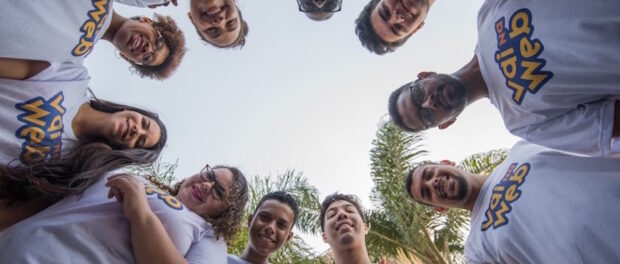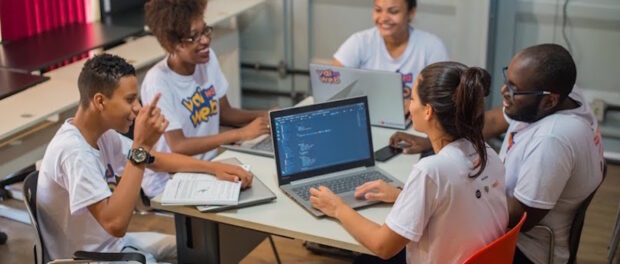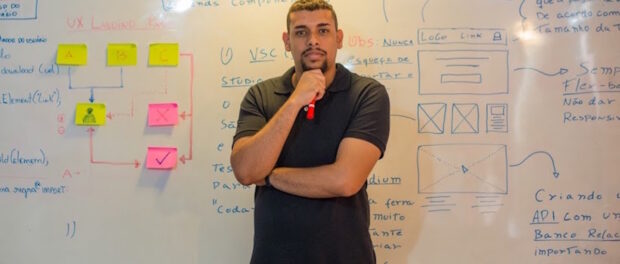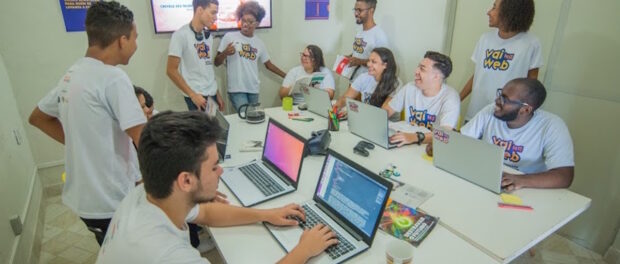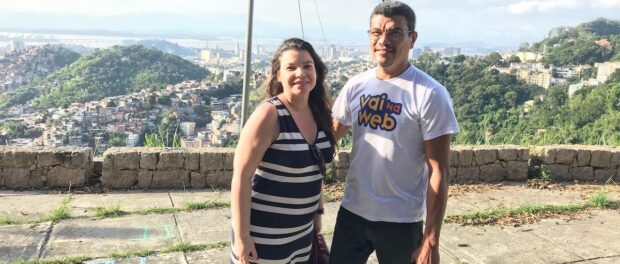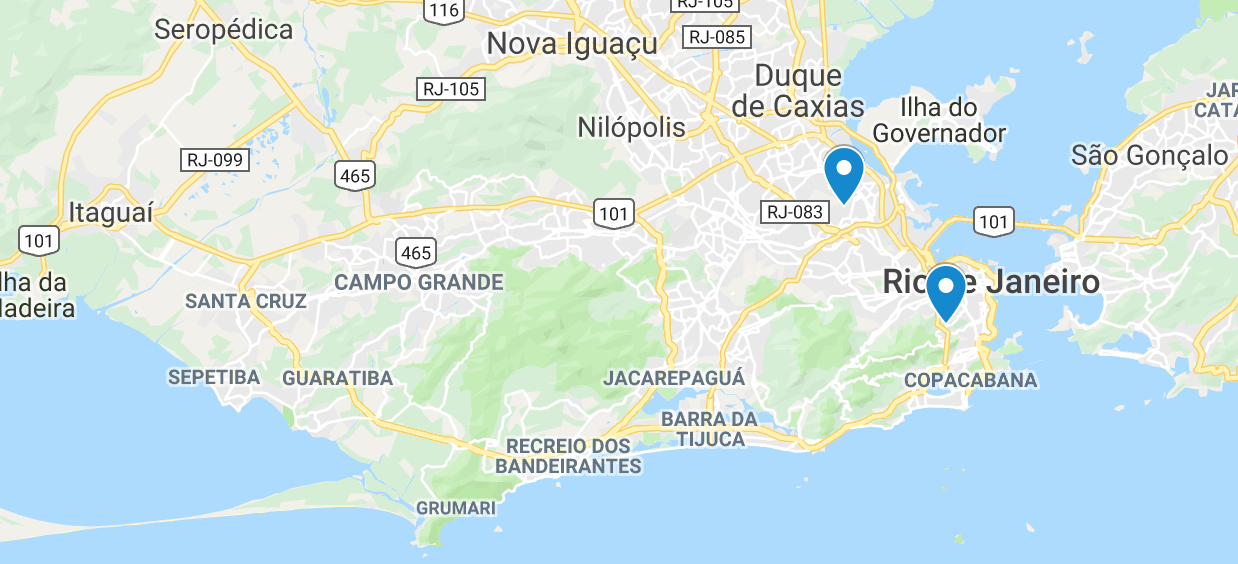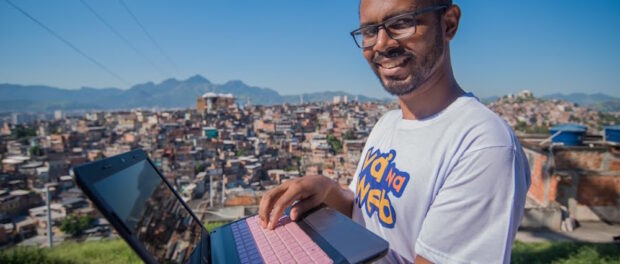
Initiative: Vai na Web (“Get Online”)
Contact: Website | Facebook | Instagram | Email
Year Founded: 2017
Community: Morro dos Prazeres (Central Rio) and Complexo do Alemão (North Zone)
Mission: To promote community improvement through socially just prosperity.
Public Events: Web and app-based platforms centered on education, social project financing, and activist-supporter articulation.
How to Contribute: Volunteer for and donate to the organization, hire a graduate of the program, or sponsor a prospective incoming student.
Morro dos Prazeres and Complexo do Alemão exemplify the many geographic, demographic, economic, and cultural differences among Rio’s numerous favelas. Built on a 55-degree slope in the hills of Rio’s central Santa Teresa neighborhood, Morro dos Prazeres—home to approximately 10,000, according to residents—has few formal roads and is among the urbanized areas situated at the highest altitudes in Rio. Despite the neighborhood’s geographic proximity to downtown Rio, residents of Prazeres report poor access to stable employment, a scenario compounded by the area’s relatively limited local commerce and access to public transit.
Meanwhile across the city, in Rio’s North Zone, Complexo do Alemão is a complex of 17 favelas home to over 150,000 residents, according to local NGOs (in comparison with census data placing the population at 70,000). Although several prominent hills lay beneath areas of Alemão, large parts of the territory are flat. With a vibrant and diverse local economy, Alemão resembles a city within a city. Its location in Rio’s largely residential and lower-middle-class North Zone, however, places residents at a distance from many career opportunities with higher earning potential and training centers.
Working in the context of these two vastly different favelas, an ingenious and burgeoning organization has begun making an impact on the lives of hundreds of families. That organization, Vai na Web, runs nine-month-long programs that provide local youth with career-valuable skills in computer science, finance, and communications—fields that the organization has identified are lacking new professionals.
In contrast to other sectors that are seeing rising unemployment in Brazil, the demand for information technology workers is rapidly increasing, Vai na Web director João Silva explains. According to the Brazilian Association for the Promotion of Software Excellence, by 2020, the Brazilian economy will lack 400,000 programmers. Taking into consideration the precarious relationship between many of Rio’s working-class families and education and employment, Vai na Web’s courses are offered for free within the community and take only a few hours per week. This way, Vai na Web cuts the commute time and extra expenses that typically come with university attendance where such courses are offered.
The initiative not only teaches youth how to enter into the job market but also partners with businesses in need of skilled employees. Silva says that students are often able to find jobs with starting salaries “far higher than those of their own parents” after completing the nine-month program. According to Vai na Web’s website, upon course completion, 48% of participants return to their studies or enter university, and 55% are employed. Graduates have even found careers outside of Brazil, such as one young man who is currently working in Canada. Another graduate, Prazeres resident Evelyn Mendes, recently gave a presentation at Stanford University in California on the social impact app that she worked on as a contributing developer, Match4Action.
Silva states that “for each extra year of higher education, you can raise your salary by ten to thirteen percent.” However, Silva and his students maintain that few residents of either Morro dos Prazeres or Complexo do Alemão see this education as attainable and even fewer go on to achieve it. As a result, one of Vai na Web’s main objectives is to convince not only the youth in the program but their families and the community as a whole that the additional time spent in school is worth their while. Two years ago when the program started, first in Alemão then in Prazeres, “the people didn’t trust us,” Silva admits. This was largely because of the failures of previous social programs within the favelas “that promised many things but yielded very little.” Many families did not see the value in sending their kids to learn programming and other computer-based skills. “One of the kids, his mother, she didn’t believe that someone could make a living sitting in front of a computer all day,” Silva says.
Nowadays, however, word has spread and at the start of each semester, hundreds apply for the few dozen class seats available at each of the sites. Talented and driven youth from all over the city have begun to take interest in the program as well. While conscious of the need to continue to support the local community, Vai na Web has begun to bring in students from other favelas as well. One student studying at the Prazeres site lives in Bangu, located 40 kilometers away in Rio’s West Zone. To arrive at class on time, she must leave home four hours before class starts. The program typically takes in youth ages 16 to 29, but for the right candidates, exceptions are made. “One of our ‘youths’ is in their 40s,” says Silva, “and next semester we will have a student who is only 13.”
Although Vai na Web’s staff is small and mostly volunteer-based, less than 20 individuals in total, they are hardworking and heavily connected to other organizations located in Rio and beyond. Instituto Precisa Ser and 1sti are two of their main sources of funding. Class space and support come from Grupo PROA (Prevention Realized Through Organization and Love), in Prazeres and EDUCAP (the Democratic Space of Union, Coexistence, Learning, and Prevention) in Alemão. Though Silva himself is not a resident of either community, his professional and academic career has been wholly centered around development and advocacy for favelas, quilombos, and other communities. Silva has been working and researching in Complexo do Alemão since 2006.
When RioOnWatch visited the project, the end of Vai na Web’s semester loomed near and students in Prazeres were diligently working on their final projects. There was a feeling of pride and positivity in the classroom, students were open to sharing their experience with the initiative, and their goals for the future. “[This program] has allowed me to develop personally and academically,” proclaimed one student. “I want to enter the market as a programmer. I don’t really care where, but I want to program,” said Giseal, an older student in the program. “When I entered this program after high school, I didn’t want to go to college,” another student, Juliana, admits. But here, everything changed. “Now, I—and really, everyone here—have the chance to attend [college] at the Getúlio Vargas Foundation (FGV) on a 100% scholarship.”
The sentiment was similar in Complexo do Alemão, where the program is run at a larger site with a larger student body. Several alumni of the program were also present during the visit and were eager to discuss how the Vai na Web program has influenced their lives. Vitor, an alumnus who has returned to help teach programming, was emphatic: “Vai na Web literally brought new horizons [to my life].” Many students agreed. “I learned much more than I could have hoped!” proclaimed one of the youngest students in the class, reflecting on the program. “Vai na Web started everything [for me],” said Ana Luiza, a graduate from the program who, after completing an internship, is now working in computer science for a company in São Paulo.
Dealing with the various pressures that come with living in these communities can make completing assignments and learning challenging. Just finishing this semester was a challenge in both communities. In Prazeres, power lines were destroyed by the heavy rains in early April, sending staff and students scrambling to find a way to power their technology-heavy classes. In Alemão, it was unsafe to have students come to class for over forty consecutive days because of heightened gun violence between traffickers and police. The neighborhood saw 103 reported shootouts registered by monitoring body Fogo Cruzado in the first 100 days of 2019, the highest level of any neighborhood in Rio de Janeiro.
Vai na Web aims to mitigate these difficulties through their socio-emotional classes, which help students remain grounded. Silva cited Paulo Freire: “when education is not liberating, the dream of the oppressed is to be the oppressor.” These classes help students in the day-to-day, as many “have violence in their homes, lack of food, [and] difficulties getting to class,” Silva explains.
Silva’s view is that Vai na Web “doesn’t spend money on [charitable] social projects. [The program] invests in the transformation of youth in Rio’s favelas.” He explains that “when you raise up a community, you create a sort of wealth,” says Silva. This is not monetary wealth, but a socially just form of prosperity that comes only from the development of education, culture, health, and sustainability. Ultimately, Vai na Web aims to change entire communities by transforming youth into skilled professionals. The program may only reach a portion of the community, but “if you can impact five percent of the community, you impact the whole community,” explains Silva.
*Vai na Web is one of over 100 community projects mapped by Catalytic Communities (CatComm), the organization that publishes RioOnWatch, as part of our parallel ‘Sustainable Favela Network‘ program launched in 2017 to recognize, support, strengthen, and expand on the sustainable qualities and community movements inherent to Rio de Janeiro’s favela communities. Check out all the profiles of mapped projects here.

